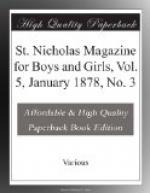You will find, if you carefully examine a bird’s wing, that all the bones and muscles are placed along the front edge, which is thus made very stiff and strong. The quill feathers are fastened in such a way that they point backward, so that the hind edge of the wing is not stiff like the front edge, but is flexible and bends at the least touch. As the air is not a solid, but a gas, it has a tendency to slide out from under the wing when this is driven downward, and of course it will do this at the point where it can escape most easily. Since the front edge of the wing is stiff and strong, it retains its hollow shape, and prevents the air from sliding out in this direction, but the pressure of the air is enough to bend up the thin, flexible ends of the feathers at the hinder border of the wing, so the air makes its escape there, and slides out backward and upward. The weight of the bird is all the time pulling it down toward the earth; so, at the same time that the air slides out upward and backward past the bent edge of the wing, the wing itself, and with it the bird, slides forward and downward off from the confined air. You will have a much better idea of this if you will cut out a little paper model of a bird’s wing and watch the way in which it falls through the air.
[Illustration]
Take a sheet of stiff paper and cut it in the shape shown in the diagram above, but considerably larger. Be very careful to have the two sides alike, so that they shall balance each other. Now fold up the front margin of each wing, along the dotted lines a, a, a, a, to form a stiff rim to represent the rim of bone along the front edge of a bird’s wing, and cut out a small strip of wood, about as thick as a match and twice as long, and run this through the two slits, b, b, to represent the body of the bird. If you hold this model about three feet from the ground, and allow it to fall gently, you will see that, instead of falling straight to the ground, it will slide forward, and strike the ground two or three feet ahead of you. It is really its weight which causes it to do this, so that the statement that a bird flies by its own weight is strictly true.
[Illustration: A SKILLFUL FLYER.]
This is true, also, of insects and bats. They all have wings with stiff front edges, and flexible hind edges which bend and allow the air to pass out, so that flying is nothing but sliding down a hill made of air. A bird rises, then, by flapping its wings, and it flies by falling back toward the earth and sliding forward at the same time. At the end of each stroke of its wings it has raised itself enough to make up for the distance it has fallen since the last stroke, and accordingly it stays at the same height and moves forward in a seemingly straight line. But if you watch the flight of those birds which flap their wings slowly, such as the woodpecker, you can see them rise and fall, and will have no trouble in




